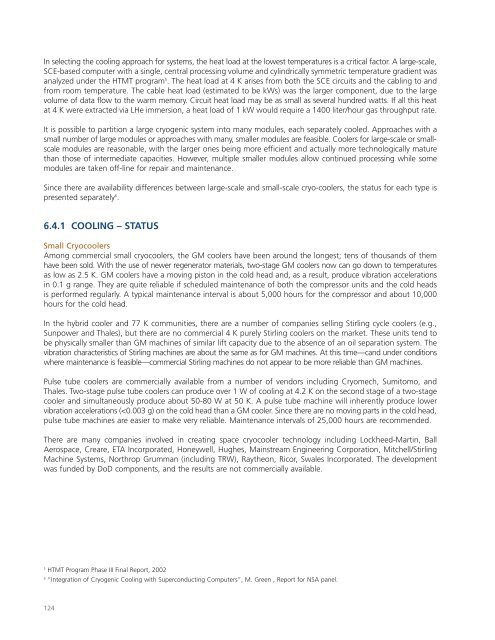Superconducting Technology Assessment - nitrd
Superconducting Technology Assessment - nitrd
Superconducting Technology Assessment - nitrd
Create successful ePaper yourself
Turn your PDF publications into a flip-book with our unique Google optimized e-Paper software.
In selecting the cooling approach for systems, the heat load at the lowest temperatures is a critical factor. A large-scale,<br />
SCE-based computer with a single, central processing volume and cylindrically symmetric temperature gradient was<br />
analyzed under the HTMT program 5 . The heat load at 4 K arises from both the SCE circuits and the cabling to and<br />
from room temperature. The cable heat load (estimated to be kWs) was the larger component, due to the large<br />
volume of data flow to the warm memory. Circuit heat load may be as small as several hundred watts. If all this heat<br />
at 4 K were extracted via LHe immersion, a heat load of 1 kW would require a 1400 liter/hour gas throughput rate.<br />
It is possible to partition a large cryogenic system into many modules, each separately cooled. Approaches with a<br />
small number of large modules or approaches with many, smaller modules are feasible. Coolers for large-scale or smallscale<br />
modules are reasonable, with the larger ones being more efficient and actually more technologically mature<br />
than those of intermediate capacities. However, multiple smaller modules allow continued processing while some<br />
modules are taken off-line for repair and maintenance.<br />
Since there are availability differences between large-scale and small-scale cryo-coolers, the status for each type is<br />
presented separately 6 .<br />
6.4.1 COOLING – STATUS<br />
Small Cryocoolers<br />
Among commercial small cryocoolers, the GM coolers have been around the longest; tens of thousands of them<br />
have been sold. With the use of newer regenerator materials, two-stage GM coolers now can go down to temperatures<br />
as low as 2.5 K. GM coolers have a moving piston in the cold head and, as a result, produce vibration accelerations<br />
in 0.1 g range. They are quite reliable if scheduled maintenance of both the compressor units and the cold heads<br />
is performed regularly. A typical maintenance interval is about 5,000 hours for the compressor and about 10,000<br />
hours for the cold head.<br />
In the hybrid cooler and 77 K communities, there are a number of companies selling Stirling cycle coolers (e.g.,<br />
Sunpower and Thales), but there are no commercial 4 K purely Stirling coolers on the market. These units tend to<br />
be physically smaller than GM machines of similar lift capacity due to the absence of an oil separation system. The<br />
vibration characteristics of Stirling machines are about the same as for GM machines. At this time—cand under conditions<br />
where maintenance is feasible—commercial Stirling machines do not appear to be more reliable than GM machines.<br />
Pulse tube coolers are commercially available from a number of vendors including Cryomech, Sumitomo, and<br />
Thales. Two-stage pulse tube coolers can produce over 1 W of cooling at 4.2 K on the second stage of a two-stage<br />
cooler and simultaneously produce about 50-80 W at 50 K. A pulse tube machine will inherently produce lower<br />
vibration accelerations (










